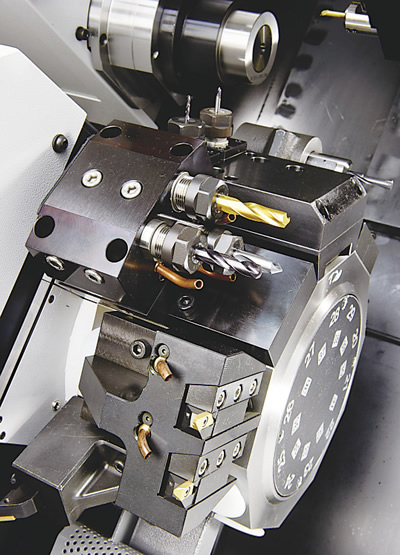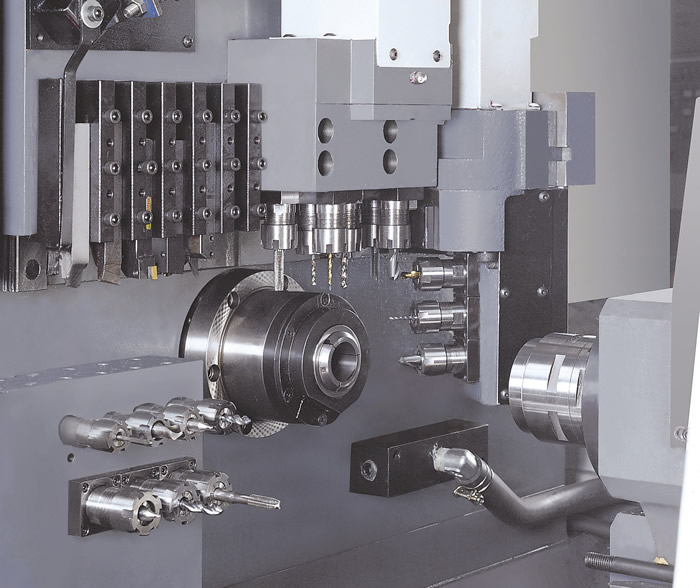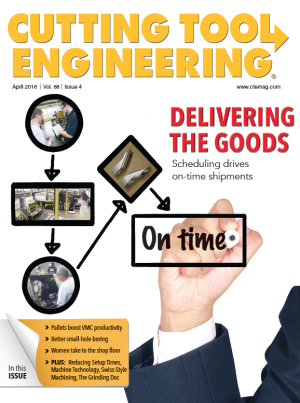If you’re shopping for a Swiss-style CNC lathe, the available options and machine configurations are truly staggering. Spindle speeds that compete with many machining centers, convertible spindles that turn a sliding-headstock machine into a chucker, thread whirling capabilities, laser cutting heads and enough axis letters to become the next Words With Friends champion.
For those unfamiliar with Swiss-style lathes, one option that may leave you scratching your head is the choice between conventional turret-mounted and gang-style, slide-mount toolholders. Conventional CNC lathe owners might lean towards the former, but each technology has its own merits that deserve careful consideration.


Turrets offer excellent rigidity, flexibility and tool selection.
Here, dozens of tool positions are available on the twin turrets
of this Cincom M-series Swiss-style CNC lathe.
Image courtesy Marubeni Citizen-Cincom.

As a rule, slides are most common on small Swiss-style lathes with spindle capacities from 7mm to 16mm (0.276” to 0.630”). Machines in this size range are typically less expensive than larger, turret-style machines for several reasons. For one, there are fewer moving parts on a slide mechanism, which makes the machine simpler to build.
And as Jeff Walz, president of machine tool distributor Eurotech, Brooksville, Fla., warned, a turret machine has additional costs. “Because of all the adapters and blocks that go with a turret, you can easily get a $20,000, $30,000 toolholder bill in addition to the price of the machine.”
Although turrets can cost more to tool up, this is easily countered by greater flexibility. “Turrets just give you tons more tools—some have upwards of 35 stations,” said Brian Such, customer support group manager at Marubeni Citizen-Cincom Inc., Allendale, N.J. “They’re also more rigid, with larger shank sizes and more power available on live-tool stations.”
With most Swiss-style machines boasting rapid-traverse rates of 100 sfm (30.48 m/min.) or higher, few would quibble over the difference in positioning time between a turret and a slide machine. Nonetheless, slides win the race by a nose. Because slides are positioned closer to the machining action than turrets, which must pull away at least a few inches before indexing, slide-mounted tools are in and out of the cut in the blink of an eye.
Regarding accuracy, slide machines often have a slight edge as well. Speaking from personal experience, it’s awfully tough to line up a turret perfectly true after a crash. Because the tool centerline on a gang slide is determined with a tool offset, alignment has historically been much simpler to accomplish. However, with most Swiss machines offering Y-axis cutting, turret misalignment is less of a concern than it once was, because the machine can compensate for an out-of-true turret with an offset in the Y-axis.


The Zeit CSL42 from Po Ly Gim Machinery Co. Ltd., distributed in the U.S. by Eurotech, accommodates
gang-style turning tools, rotary cutters, B-axis capabilities and a subspindle with end-working tools.

Such and Walz agreed that because tools can be indexed to a convenient position, tool changes are easier on turret machines. Tool placement on gang slides is often tight, especially on small machines, and, on those with opposing slides, the tools on the back are usually upside down, making it easy to drop a screw or insert into the chip pan. Some of this grief can be avoided by placing the most-frequently changed tools closest to the front of the machine, where they’re easier to reach.
In any event, Swiss operators must continue to adapt to whatever new technology comes their way. Hybrid Swiss-style CNCs, with both slide and turret technology, are becoming increasingly common. Such recommends that making full productive use of these machines requires a solid understanding of the control’s “synch” functions, so both the turret and slide can be engaged simultaneously.
“Quite often, I’ll visit shops with these beautiful machines and they’re not using even basic functionality,” he said. “Things like synchronous cutting and superimposition of the axes require nothing more than a G code and are great tools for cycle-time reduction. If you have a machine like this, you really need to take full advantage of its capabilities.”
Contact Details
Contact Details
Related Glossary Terms
- centers
centers
Cone-shaped pins that support a workpiece by one or two ends during machining. The centers fit into holes drilled in the workpiece ends. Centers that turn with the workpiece are called “live” centers; those that do not are called “dead” centers.
- computer numerical control ( CNC)
computer numerical control ( CNC)
Microprocessor-based controller dedicated to a machine tool that permits the creation or modification of parts. Programmed numerical control activates the machine’s servos and spindle drives and controls the various machining operations. See DNC, direct numerical control; NC, numerical control.
- lathe
lathe
Turning machine capable of sawing, milling, grinding, gear-cutting, drilling, reaming, boring, threading, facing, chamfering, grooving, knurling, spinning, parting, necking, taper-cutting, and cam- and eccentric-cutting, as well as step- and straight-turning. Comes in a variety of forms, ranging from manual to semiautomatic to fully automatic, with major types being engine lathes, turning and contouring lathes, turret lathes and numerical-control lathes. The engine lathe consists of a headstock and spindle, tailstock, bed, carriage (complete with apron) and cross slides. Features include gear- (speed) and feed-selector levers, toolpost, compound rest, lead screw and reversing lead screw, threading dial and rapid-traverse lever. Special lathe types include through-the-spindle, camshaft and crankshaft, brake drum and rotor, spinning and gun-barrel machines. Toolroom and bench lathes are used for precision work; the former for tool-and-die work and similar tasks, the latter for small workpieces (instruments, watches), normally without a power feed. Models are typically designated according to their “swing,” or the largest-diameter workpiece that can be rotated; bed length, or the distance between centers; and horsepower generated. See turning machine.
- shank
shank
Main body of a tool; the portion of a drill or similar end-held tool that fits into a collet, chuck or similar mounting device.
- toolholder
toolholder
Secures a cutting tool during a machining operation. Basic types include block, cartridge, chuck, collet, fixed, modular, quick-change and rotating.
- turning
turning
Workpiece is held in a chuck, mounted on a face plate or secured between centers and rotated while a cutting tool, normally a single-point tool, is fed into it along its periphery or across its end or face. Takes the form of straight turning (cutting along the periphery of the workpiece); taper turning (creating a taper); step turning (turning different-size diameters on the same work); chamfering (beveling an edge or shoulder); facing (cutting on an end); turning threads (usually external but can be internal); roughing (high-volume metal removal); and finishing (final light cuts). Performed on lathes, turning centers, chucking machines, automatic screw machines and similar machines.



